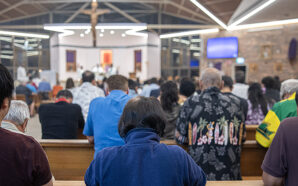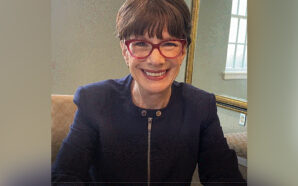“The Jews killed Jesus.” For much of church history, this erroneous, unjust and lethal accusation of Jewish collective guilt held sway among Christian populations. It was never defined as doctrine. However, as a sentiment and pattern of thought, the deicide charge (Jews accused of being “Christ-killers” or murderers of God) caused grievous harm to Jewish lives.
It was repudiated by the Second Vatican Council in its Declaration on the Relationship of the Church to Non-Christian Religions:
“[W]hat happened in His passion cannot be charged against all the Jews, without distinction, then alive, nor against the Jews of today…
“[T]he Jews should not be presented as rejected or accursed by God, as if this followed from the Holy Scriptures. All should see to it, then, that in catechetical work or in the preaching of the word of God they do not teach anything that does not conform to the truth of the Gospel and the spirit of Christ….
“[The Church] decries hatred, persecutions, displays of anti-Semitism, directed against Jews at any time and by anyone.” (Nostra Aetate, 4)
Thus did the Catholic Church, with the authoritative weight of an Ecumenical Council, dismantle a key pillar of the “teaching of contempt” – a term that refers to the antagonistic attitude towards the Jewish people which had infected Christian communities since the early centuries of Christianity’s development.
Post-conciliar ecclesial documents have reinforced this teaching and promoted a “teaching of respect”. In particular, teachers and homilists today are urged to take great care with Scripture so as not to perpetuate patterns of anti-Judaism. For example, in these statements of the Holy See’s Commission for Religious Relations with the Jews, we read:
“With respect to liturgical readings, care will be taken to see that homilies based on them will not distort their meaning, especially when it is a question of passages which seem to show the Jewish people as such in an unfavourable light. Efforts will be made so to instruct the Christian people that they will understand the true interpretation of all the texts and their meaning for the contemporary believer.” (Guidelines, 1975, II)
“The Gospels are the outcome of long and complicated editorial work… Certain controversies reflect Christian-Jewish relations long after the time of Jesus. To establish this is of capital importance if we wish to bring out the meaning of certain Gospel texts for the Christians of today. All this should be taken into account when preparing catechesis and homilies for the last weeks of Lent and Holy Week.” (Notes, 1985, IV, 21)
Such healing steps, taken by the Catholic Church and by other mainstream Churches, are of critical importance. However, the task of addressing ingrained prejudice is far from complete. The old contemptuous view that held Jews to be rejected by God, is still capable of tugging at the Christian mindset in subtle and subconscious ways, especially during Passion Sunday and Good Friday where the Passion narrative is prominent in the liturgical rhythm.
What might we do about this? How can Christian minds be fortified against subtle anti-Jewish bias, infiltrating hearts, as we listen to the evocative strains of the Passion story read, and perhaps also enacted, on Palm Sunday and Good Friday?
This question is especially pertinent in the current climate, when Jewish communities around the world are experiencing unprecedented levels of antisemitism and tensions emanating from conflict in the Middle East are tearing at the fabric of normally peaceful societies.
Here are ten suggestions, for this year and future years:
- View a series of short videos “Presenting the Passion…Without Blaming the Jews” (available at ICCJ.org) by leading scholars in the field of Jewish-Christian relations.
- Consult these guidelines (US Bishops) when planning dramatisations of the Passion story.
- Become educated in the history of the Church’s journey as it repented of the “teaching of contempt” and embraced the “teaching of respect”. A fascinating work that traces the development of Nostra Aetate is John Connelly’s From Enemy to Brother. The Revolution in Catholic Teaching on the Jews 1933-1965 (Cambridge: Harvard University Press, 2012).
- As part of a Christian prayer life, approach Jesus with a consciousness of his Jewish identity and his Jewish kinship ties, in keeping with the Gospel narratives.
- Ask Jewish friends about how they perceive the history of Christian anti-Judaism and how it has impacted them or their own family’s story or community’s history. Listen and learn.
- Learn to identify age-old antisemitic stereotypes at work in present-day hate speech.
- In Lent and Holy Week each year, include a prayer of lament for Christianity’s long history of anti-Judaism and antisemitism, perhaps similar to the prayer of Pope John Paul II during his historic visit to the Western Wall in Jerusalem (Judaism’s holiest site) in 2000.
- Pay attention to contemporary church statements on Jewish-Christian relations, such as the documents quoted above. Many more can be found at the Dialogika online library.
- Learn about the interfaith significance of the powerful sculpture Synagoga & Ecclesia in Our Time, by Joshua Koffman, located at Saint Joseph’s University, Philadelphia.
- The best antidote to prejudice is conscious acts of love. In an examination of conscience, review your speech and actions in relation to Jews and Judaism, taking a lead from these words of Pope John Paul II:
“For the Jewish people themselves, Catholics should have not only respect but also great fraternal love for it is the teaching of both the Hebrew and Christian Scriptures that the Jews are beloved of God, who has called them with an irrevocable calling. No valid theological justification could ever be found for acts of discrimination or persecution against Jews.” (Address to Australian Jewish Community, 26 November 1986)
Finally, we can ponder these words from Nostra Aetate, 4-5, which underscore God’s love for the whole human family, and our vocation to love God and neighbour, inseparably:
“Christ underwent His passion and death freely, because of the sins of humanity and out of infinite love, in order that all may reach salvation. It is, therefore, the burden of the Church’s preaching to proclaim the cross of Christ as the sign of God’s all-embracing love and as the fountain from which every grace flows.
“We cannot truly call on God, the Father of all, if we refuse to treat anyone as a brother or sister, created as he or she is in the image of God. People’s relation to God the Father and their relations to others as brothers and sisters are so linked together that Scripture says: ‘The one who does not love does not know God’ (1 John 4:8).”
Teresa Pirola, ThD is a Sydney-based writer and author of Catholic-Jewish Relations: Twelve Key Themes for Preaching and Teaching (Paulist Press, 2023).
This article was originally published on Dr Pirola’s website Light of Torah, and is reproduced with permission.








